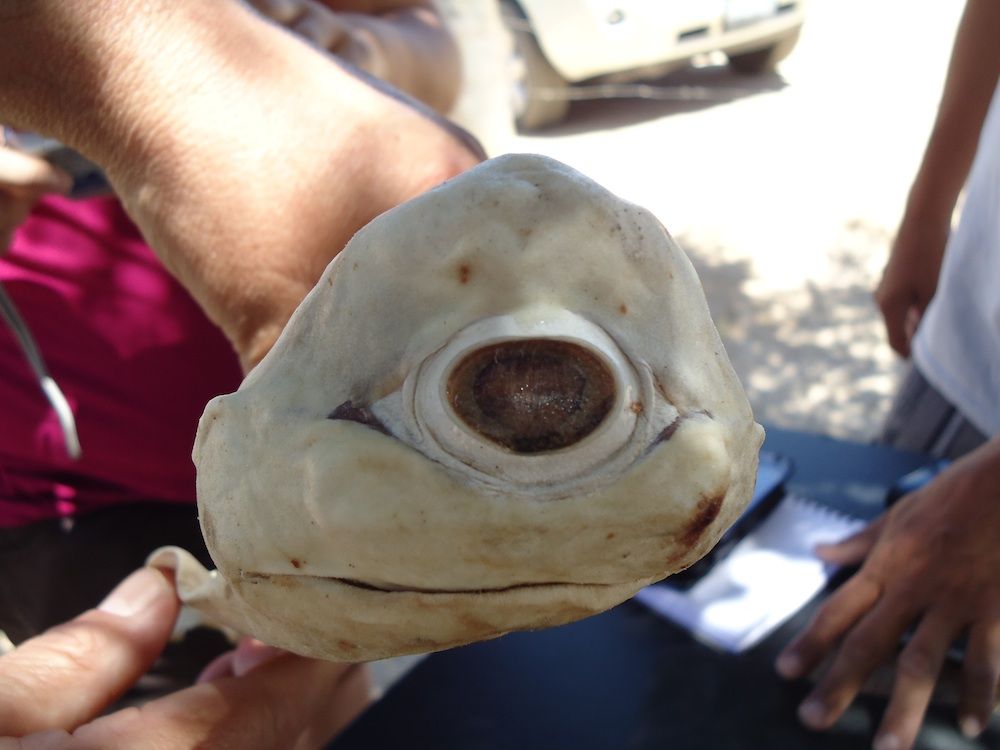10 Wacky Animal Stories of 2011

As the year draws to a close, here's a look back at some of the weirdest animal discoveries of 2011. From transvestite birds to zombie caterpillars and our own set of animal superheroes, it's been a wacky ride.
#1. A-Flock-Alypse?
This year started with a bang as scores of birds fell from the skies in January. The "aflockalypse" as it became called, harkened back for many to their first time watching Alfred Hitchcock's psychological thriller "The Birds," but experts agreed that the birds' and fish's mass deaths were just coincidental.
It started with the mysterious deaths of thousands of blackbirds in Arkansas and Louisiana around New Years' eve; this was followed by several reports of dead fish washing ashore and many more "massive" animal die-offs. In the end, the bang with which it all started was probably fireworks, which initially killed the blackbirds. Researchers agree the best explanation so far is the fireworks' noise and lights may have scared or disoriented the birds, causing them to fatally injure themselves flying into buildings, water towers and trees. The wide pickup of the original blackbird story probably set off the media attention later stories received, but these kind of die-offs are normal, researchers and ecologists say.
#2. Zombie Ants
The year was a big one for zombie insects. Reports of mind-controlled ants and caterpillars were enough to creep out even the least squeamish.
In May, in the journal BMC Ecology, researcher David Hughes from Pennsylvania State University reported that a parasitic fungus infects forest ants to fulfill its bidding. The fungus fills the ant's head with fungal cells and changes its muscles so the ant can grab a leaf in a death grip just when and where the fungus wants it — specifically, the zombie ants all bite down around noon, then all die together around sunset, like some weird fungus-addled ant cult. The fungus then bursts out of the ants' heads and spreads its spores to its next unwitting victim.
Sign up for the Live Science daily newsletter now
Get the world’s most fascinating discoveries delivered straight to your inbox.
Another report in September found the genetic culprit that sends caterpillars to the treetops, where they liquefy and rain infectious death down on their peers. The virus that zombifies these gypsy moth caterpillars also makes sure they grow as large as possible so they spread infectious viruses far and wide, said study researcher Kelli Hoover, of Pennsylvania State University. They also send the caterpillars crawling up trees in the middle of the day, when they are most vulnerable to bird attacks.
#3. The mouse with two dads
In a wacky feat of genetic engineering and a stem-cell switcheroo, researchers created the first mouse baby from the genes of two male mice — a mouse that literally has two dads. The mousey Dr. Frankensteins, from the M.D. Anderson Cancer Center in Houston, turned cells from Dad No. 1 into X-only stem cells, which they injected into an egg to make a female mouse, which was then fertilized by sperm from Dad No. 2.
The study, published in the journal Biology of Reproduction, is the first step to making human children from two men, though that is a long way away. This mean feat of genetic engineering was also dubbed by LiveScience reporter Stephanie Pappas as "scientific progress at its cutest" when she met the mice in person.
#4. Animals with superhero senses
Scientists aren't the only ones turning miraculous tricks this year. Mother Nature has a few up her sleeve as well. Animal super senses turned up in dolphins and vampire bats in 2011, and even one possible sixth sense in humans made an appearance.
Researchers at Rostock University in Germany discovered that the common Guiana dolphin has a special sixth sense: It can sense electric fields with a special organ on its snout. While the ability is common in fish, the dolphins are the first placental mammal (as opposed to a marsupial mammal) found to sense electricity, which they probably use to find fish in the shallow, murky waters they call home.
In other odd animal senses, researchers discovered in August that the vampire bat can "see" heat from veins and arteries using a special organ on its nose that is incredibly sensitive to heat. The bat uses this organ to find blood meals and to bite the right part of the skin: A mouthful of hair is unappetizing to these little bloodthirsty critters.
A possible extra human sense also made an appearance this year. A human protein, when expressed in fruit flies, has the ability to detect magnetic fields. The researchers caution that the protein might not work that way in humans, though. Sorry, Magneto wannabees.
#5. Strange sperm
It may not be super, but strange sperm abounds in the animal kingdom.
Studies in naked mole rat sperm show that these weird little creatures also have weird little sperm. In any other animals their sperm samples wouldn't pass quality control, but these eusocial underground rodents make do just fine with their mutant sperm, a study published in the December issue of the journal BMC Evolutionary Biology shows.
Ducks also have special sperm properties, another 2011 study shows. Their sperm contains antibiotics that might protect them and their mates from sexually transmitted infections. The brighter their bill is, the better their sperm is at killing off bacterial invaders, suggests the study published in April in the journal Biology Letters.
#6. More strange sex
Sperm wasn't the only weird animal-sex finding of 2011. Multiple studies found everything from hermaphroditic bulldogs to sexually confused fish and birds.
The bulldog Bijou is genetically female, but has some physical properties of a male dog, including a prostate gland and testicles. Researchers are stumped as to why this pup, and another bulldog, Tana, had these male characteristics without male genes.
Other ambiguously sexed animals are also stumping researchers this year: A cardinal with half-male, half-female coloring seems to be a genetic anomaly, with half-female and half-male cells. Several sex-changing birds also made the news in 2011, including a female chicken that transformed into a rooster in the United Kingdom over a few weeks time. Researchers think that a tumor or cyst may have caused the switch.
Some birds of prey don female plumage, but don't actually change gender. These transvestite marsh harriers use such sexual mimicry to fool other males into leaving them alone, researchers reported this year.
#7. Cyclops shark
Strange sex-changing animals weren't the only weirdoes nature threw at us this year. A Photoshop-quality image of a fetal shark with one eye stunned researchers and cybergawkers alike when it made the news in October. The one-eyed fetus was cut from the belly of a shark in the Gulf of California, but would not likely have survived outside of the womb.
"This is extremely rare," shark expert Felipe Galvan Magana of Mexico's Centro Interdisciplinario de Ciencias del Mar told the Pisces Fleet Sportfishing blog in July. "As far as I know, less than 50 examples of an abnormality like this have been recorded." [Photos of Cyclops Shark]
Other, less scientifically based reports of Yeti nest sightings and hair samples from Russia splashed the news this year. And scientists reported finding the lair of a 'Kraken' sea monster, though the interpretation of the finding has not been substantiated.
#8. Fishy sexual harassment
Several advancements in the field of fishy sexual harassment made the news this year, indicating that Trinidadian guppies seem to have more gossipy drama and sexual tension than an episode of "Sex in the City."
A study published in October showed that when a harassing male chases down female guppies, they are more likely to get in fights with other females. The sexually charged males stress these females out so much they end up turning on each other, the researchers said.
Another study showed that these same guppies, when harassed, pair up with prettier females, whose presence draws attention away from themselves.
#9. Animals with protective poisons
Scientists have long understood that plants use poison to defend themselves, but traditionally animals are thought to defend themselves with weapons like sharp teeth and claws. In 2011, a number of animals were discovered to wield poisons of their own.
By utilizing the same plants that African tribesmen use to poison their arrows, the furry fury known as the African crested rat can incapacitate and even kill predators many times its size, research published in August found. The rat chews poisonous bark and spits the poison onto its furt coat, which has specialized hairs with pores to absorb the animal's poisonous spit, which protects them against predators like dogs.
Another odd animal poison discovered in 2011 is the cyanide-sweating millipede discovered in September. When disturbed, the bugs emit a toxic cyanide goo and foul-tasting chemicals that deter predators looking for a snack. Luckily for its predators this odd insect also has a nighttime glow to warn predators of its poisonous secretions
#10. The loudest genitals
One loud little insect makes a big call, from an unorthodox organ. Research published in July indicates that by using its genitals, the water boatman makes the loudest song for its size: At less than one-tenth of an inch (2.3 millimeters) long, it calls out to mates at over 99 decibels, as loud as an orchestra. The odd insect's song from the depths of a river can even be heard along its banks, the researchers said, and is likely created when the animal rubs its genitals against ridges on its body, though the scientists aren't sure how the sound gets so loud.
Jennifer Welsh is a Connecticut-based science writer and editor and a regular contributor to Live Science. She also has several years of bench work in cancer research and anti-viral drug discovery under her belt. She has previously written for Science News, VerywellHealth, The Scientist, Discover Magazine, WIRED Science, and Business Insider.











